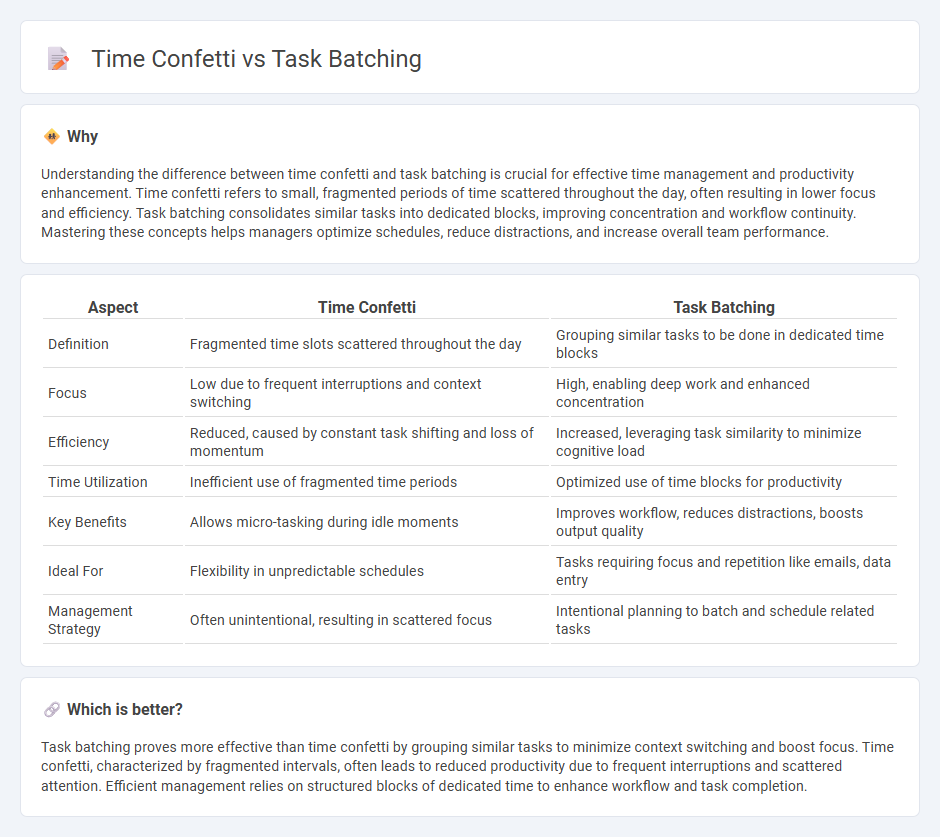
Time confetti refers to scattered, fragmented moments of productivity often caused by frequent interruptions and multitasking, reducing overall efficiency. Task batching involves grouping similar tasks together to minimize context switching and enhance focus, leading to improved time management. Discover strategies to balance these approaches for optimal workflow and productivity.
Why it is important
Understanding the difference between time confetti and task batching is crucial for effective time management and productivity enhancement. Time confetti refers to small, fragmented periods of time scattered throughout the day, often resulting in lower focus and efficiency. Task batching consolidates similar tasks into dedicated blocks, improving concentration and workflow continuity. Mastering these concepts helps managers optimize schedules, reduce distractions, and increase overall team performance.
Comparison Table
| Aspect | Time Confetti | Task Batching |
|---|---|---|
| Definition | Fragmented time slots scattered throughout the day | Grouping similar tasks to be done in dedicated time blocks |
| Focus | Low due to frequent interruptions and context switching | High, enabling deep work and enhanced concentration |
| Efficiency | Reduced, caused by constant task shifting and loss of momentum | Increased, leveraging task similarity to minimize cognitive load |
| Time Utilization | Inefficient use of fragmented time periods | Optimized use of time blocks for productivity |
| Key Benefits | Allows micro-tasking during idle moments | Improves workflow, reduces distractions, boosts output quality |
| Ideal For | Flexibility in unpredictable schedules | Tasks requiring focus and repetition like emails, data entry |
| Management Strategy | Often unintentional, resulting in scattered focus | Intentional planning to batch and schedule related tasks |
Which is better?
Task batching proves more effective than time confetti by grouping similar tasks to minimize context switching and boost focus. Time confetti, characterized by fragmented intervals, often leads to reduced productivity due to frequent interruptions and scattered attention. Efficient management relies on structured blocks of dedicated time to enhance workflow and task completion.
Connection
Time confetti, characterized by small, fragmented intervals of attention, disrupts productivity by scattering focus across multiple tasks. Task batching counters this by grouping similar activities together, reducing cognitive switching and improving efficiency. Together, these concepts highlight the importance of structured time management in enhancing workflow and minimizing distractions.
Key Terms
Productivity
Task batching enhances productivity by grouping similar tasks to minimize context switching, leading to deeper focus and efficient workflow. Time confetti, characterized by fragmented moments between larger tasks, often results in frequent interruptions and scattered attention. Explore effective strategies to optimize your workday and maximize productivity by balancing task batching and managing time confetti.
Focus
Task batching groups similar tasks to minimize context switching, enhancing cognitive focus and productivity. Time confetti refers to fragmented, unpredictable time slots that disrupt concentration and reduce efficiency. Explore strategies to balance these approaches and master sustained focus.
Distraction
Task batching minimizes distraction by grouping similar tasks together to maintain focused attention, reducing the constant context switching that fragments cognitive resources. Time confetti refers to scattered, interrupted time segments caused by frequent distractions, leading to diminished productivity and increased mental fatigue. Discover effective strategies to overcome these challenges and enhance your focus.
Source and External Links
Task Batching: A Guide to Improving Your Work Productivity - This guide explains how task batching helps increase productivity by reducing context switching and organizing tasks into focused blocks.
Task Batching: Simplify Your Schedule and Increase Productivity - This article provides steps to implement task batching, including categorizing tasks and dedicating time blocks to each category.
How task batching can increase your productivity at work - This resource discusses using task batching to avoid multitasking and enhance focus, leading to increased productivity and better work quality.
 dowidth.com
dowidth.com